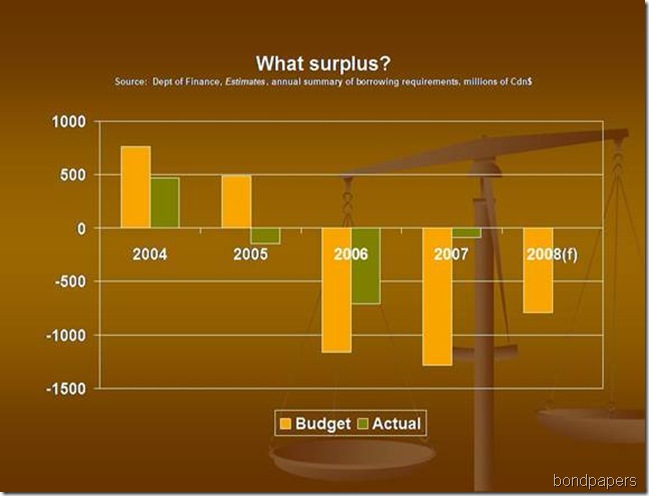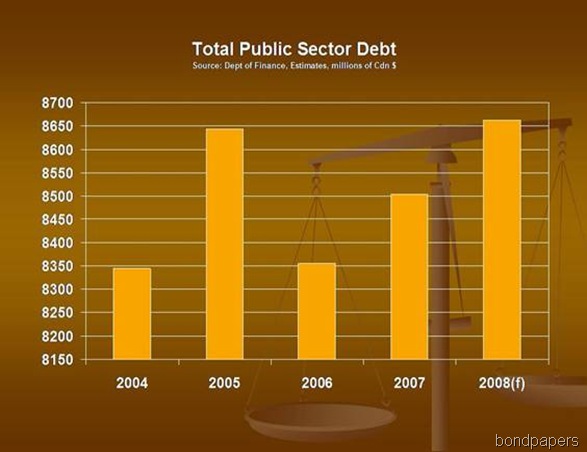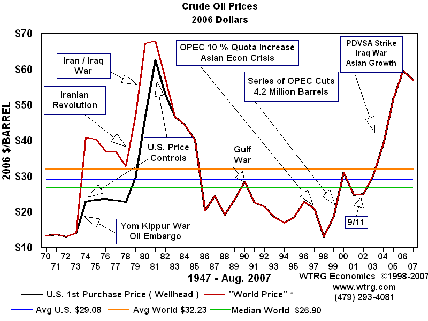Give credit for the title to CBC television's
supperhour news and the banter between the anchors after a segment on Premier Danny Williams' comments on Wednesday about the ongoing racket with Ottawa about Equalization and offsets.
Williams was back in the province today after spending a couple of weeks someplace sunny.
Brown he is, thanks to a tan.
Browned off?
Well, that's a local expression for being annoyed or upset.
In a scrum with reporters on Wednesday, Williams called for finance minister Jim
Flaherty to
resign. Williams also tore strips off federal fish minister Loyola
Hearn - the regional minister for Newfoundland and Labrador - as well as Conservative members of parliament Fabian Manning and Norm Doyle.
One of the consistent problems for anyone trying to figure out the whole issue is what the federal government has actually done. Skim through the initial budget
documents and one would have a hard time finding any reference to a cap being applied to both the 1985 Atlantic Accord and to the 2005 offset agreement. What you will find is the following reference to Equalization:
A fiscal capacity cap to ensure that Equalization payments do not unfairly bring a receiving province’s overall fiscal capacity to a level higher than that of any non-receiving province.
Many people in Newfoundland and Labrador - your humble e-scribbler included - took this to mean that the existing offset agreements, both of which are tied to Equalization and are limited in duration, would still operate until such time as Newfoundland and Labrador exceeded the national per
capita fiscal capacity as determined by whatever Equalization formula is in effect.
It appears that Memorial University economist Wade Locke worked on the same assumption for his
initial analysis, even after extensive discussions with federal officials. Danny Williams certainly appears to have taken that meaning from the federal budget. He told a CBC radio audience on March 26 that the province would likely opt for the O'Brien formula by 2009. That would be consistent with Locke's assessment, made public two weeks after Williams made those comments
It seems as well that federal fisheries minister Loyola
Hearn had a similar impression. He assured Newfoundlanders and
Labradorians that once they saw the details, their initial fears would be allayed. That was what he said on
March 22. As recently as last
Friday, he said much the same thing.
Hearn is a smart old politician and he is just too smart to fall into the sort of trap that his predecessor John
Efford built for himself and then jumped into.
That perspective on the offset agreements changed on Monday with Jim
Flaherty's admission that in fact the federal government would be unilaterally applying caps to the agreements. Of course, in the process,
Flaherty had to savage a few facts, but that seems to be a common feature of public life these days.
Taken altogether, it's easy to understand Danny Williams' latest anger. He's right, by the way:
Flaherty jerked everybody around. The federal finance leprechaun has been too cute by half. Williams hasn't pointed it out - and he likely won't, but the changes to the 1985 Atlantic Accord have far more serious implications than anything else.
That deal is not just a simple piece of legislation to be changed at a whim. It represents the basis on which Newfoundland and Labrador derives all its oil and gas benefits. The federal legislation enables a landmark agreement in federal-provincial relations and the offset benefits - temporary and declining are a part of the package of financial benefits it contains. The Equalization offsets were intended to provide additional cash to Newfoundland and Labrador on a temporary basis to allow for economic infrastructure development that, frankly, hasn't really been possible until recently.
Williams winds up with a few of problems as he looks at the current federal-provincial mess.
Biggest among them is that he simply has absolutely no means of communicating seriously with the federal government. His last potential allies - the three Conservative
MPs - are all dirt under his feet. Williams started the whole mess with Harper at least last October in Gander, and as much as he insists he did the right thing, kicking the Prime Minister in the crotch - publicly - isn't designed to win any friends.
And friends are needed in politics. Even if people aren't friends, you at least need them to not be enemies. Politics is about the art of the deal, about maximizing gains inside a realistic set of options. It's not about Mr. Right, to steal a phrase. Sometimes it's about Mr. Right for Now. Perfect isn't ever possible, but there are plenty of really good possibilities short of perfection. you can cut those deals - good, beneficial deals - on a range of issues if your head is screwed on properly.
But if all you do is set fire to their underwear, the odds of winning people over is slim. When you take to their Stanfield's with a flamethrower, well don't be surprised if they don't invite you over to dinner to meet the kids and the rest of the family. Be surprised if they don't look for a restraining order.
On another level, though, Williams' fundamental argument isn't designed to win converts from among the non-converts. We've said it before. For the federal government and for
mainlanders generally, we need to explaining what is in it for them. The Premier hasn't been able to do that, at all.
The weakness of the whole Equalization argument about
clawbacks - as fraudulent as it is - takes away the one selling point: we make money; you make money. Instead, them making money becomes a crime. They - the undifferentiated foreign exploiting demons - take what is ours and, according to Williams, by God he will get it back by force if necessary. Any wonder people have tuned out?
Of course, it really doesn't help when your finance minister rejects deficit and debt fighting all the while you are holding out a big debt as one of the big reasons you need federal hand-outs.
Danny Williams lamented recently that
mainlanders don't seem to understand how prosperity here benefits there, wherever there is.
Well, the real test of his abilities as a Great Negotiator and a politician will be in how he tackles that challenge.
It's his job to explain the point. He
can do it.
The question is will he.
Doing an endless repetition of one of his first
interviews - three
freakin' years later - just isn't cutting it so far.

 But that isn't the official budget of the provincial government approved in the House of Assembly any more than all the talk by politicians about surpluses the past few years was accurate either.
But that isn't the official budget of the provincial government approved in the House of Assembly any more than all the talk by politicians about surpluses the past few years was accurate either. At the same time, very little attention has been paid to paying down the large amount of debt - the accumulated deficits - that now runs upwards of $8.5 billion and is expected to climb higher this year.
At the same time, very little attention has been paid to paying down the large amount of debt - the accumulated deficits - that now runs upwards of $8.5 billion and is expected to climb higher this year.